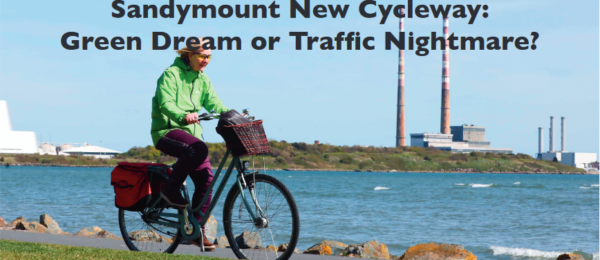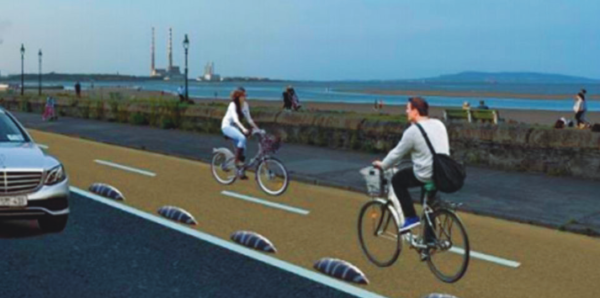
RollingNews.
Eoin Meegan
A new ambitious plan for the southside of Dublin Bay envisages a cycle path going all the way from Sandymount to Sandycove beyond Dún Laoghaire. As part of this plan a new cycleway will run along the Strand Road in Sandymount on a trial basis for six months starting January 15th. It will involve a dedicated two-way cycleway on the seafront with general traffic confined to a single lane for outbound traffic heading in the direction of the Merrion Gates. The cycle track will run from Sean Moore Road to the Merrion Gates, marked off with orcas and bollards, which can be adjusted if needs be.
This follows a public consultation which received just under 3,000 submissions with 56% of respondents in favour. However, a large number of local residents are set against it, and express what may be very legitimate concerns. A group, which represents residents on Serpentine Avenue, Tritonville Road, Claremont and adjoining roads (called the STC) fear that the loss of an inbound traffic lane will mean vehicles trying to access the East Link Bridge will find themselves having to take a detour through residential streets, increasing the traffic to dangerous levels there and causing congestion and unnecessary hardship.
Local resident David Reddy told NewsFour: “Folk in Alban’s Park are only realising now that with no right turn at Merrion Gates they have a 5.5km diversion via Serpentine Ave which will take a fair while just to get home. Even at the moment, it’ll mean approx 7,000 cars and trucks a week will have to filter through Sandymount to access Sean Moore Road.”
Transport modelling does seem to back this up, indicating an increase in traffic in Sandymount Village and along Gilford Road. However the Council argue that these areas have seen a decrease in traffic since the Covid restrictions, and they point out that the area will be covered by the SCAT system which allows real time adjustment of traffic signals to deal with traffic build-up.
A big concern is that sport and local sporting clubs could be a major casualty from diverted traffic and rerouted buses. “Between them they’ve close to 2,000 juveniles involved as well as a substantial number of adults. It looks like Park Avenue will become a “rat run” as well as a route for Nos. 1 and 47 buses. This could severely threaten clubs’ ability to function. Clanna Gael will also have difficulties accessing the clubhouse.” Mr Reddy continues.
Dublin City Council says it will be carefully monitoring the scheme, with extra pedestrian crossings being installed in Sandymount village to regulate speeds, and additional traffic cameras on the way. Further they point out that the scheme will involve minimal civil works and will be installed in such a way as to allow for localised alterations, and little public inconvenience in putting down the track. After the six-month trial the scheme will be re-evaluated with permanent infrastructure put in place only if it is successful.
Independent Councillor Mannix Flynn said local residents will be disappointed and the council should now work with them to find a solution acceptable to all. Another local councillor, Dermot Lacey (Lab), also expressed disappointment and said he is concerned with the lack of monitoring for problems as they occur.

It seems grossly unfair to expect those living in the area to put up with ever increasing traffic flows through their village, not to mention the added danger. But what’s really angering many of the residents is the lack of real consultation with local people. However, the alternative plan put forward by the STC which would see cyclists sharing space with people at bus stops and cars entering three existing car parks, hardly reads like a viable alternative. Most damning is that the cycleway would actually cease to exist for the last 270 metres approaching the Merrion Gates. This has already been rejected by the National Transport Authority. The STC’s defence is to point to where shared space in tight spots around the country is common for cycle lanes (hardly an argument likely to endear them with cyclists!)
The council emphasise that their main objective is to introduce a cycleway that works and that is safe:
“The city council believes that the trial is an opportunity in general to reduce the traffic volumes on Strand Road while implementing a range of measures to ensure that traffic volumes on other streets do not reach levels that would have any seriously adverse impacts on residents.”
An exasperated David Reddy told NewsFour: “I’m primarily involved in trying to save the area I was born into and lived ever since from being destroyed by a pound shop cycleway. There have been funds available at various times since the 1980s to build a proper cycleway but DCC have talked and talked but done nothing. Now there is a heap of money available but still DCC won’t commit to doing it properly.”
A plan that envisages 10km of protected safe cycling from the Strand Road to Sandycove certainly lacks neither initiative nor innovation. Undoubtedly as we move towards an environment of cleaner air and green spaces, and with ever more spaces being allocated for cyclists and pedestrians the new proposal does carry a lot of merit. However, it’s to be hoped that any permanent changes in the future will be done in consultation with locals and will not come at the expense of small historical villages.



